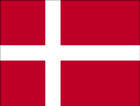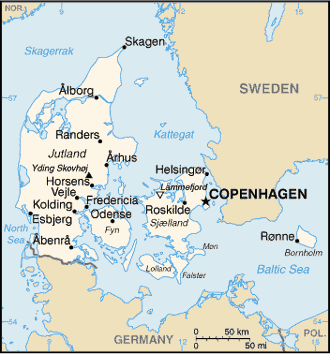|
Denmark
|

|
Capital: Copenhagen
Population: 5,771,876
Brief History of Denmark:
Denmark has been inhabited by the Danes since its early prehistoric history. The Vikings rose to power during the 9th century. Over the next 300 years Vikings would raid and explore areas around Denmark all the way to the island of England. In the late 1300s the Danish Crown became powerful. Queen Margrethe I united Denmark, Norway, Sweden, Finland, and Iceland. This unity lasted until 1520 when Sweden and Finland left the union. Norway left in 1814.
The Danish Monarchy is over 1000 years old and is one of the oldest monarchies in the world. One of the more famous kings was King Christian IV who ruled Denmark for 59 years. He brought many reforms to the country and also built many structures and towns.
During WWI Denmark remained neutral and tried to do the same during WWII. However, Germany invaded and took control of Denmark in 1940. Resistance groups formed within Denmark to help fight the Germans and in 1945 they were freed by the Allies.
Although Danish is the principal language in Denmark, many Danish speak fluent English. The country is run by a constitutional monarchy today where the Queen is largely a figurehead.
The Geography of Denmark
Total Size: 43,094 square km
Size Comparison: slightly less than twice the size of Massachusetts
Geographical Coordinates: 56 00 N, 10 00 E
World Region or Continent: Europe
General Terrain: low and flat to gently rolling plains
Geographical Low Point: Lammefjord -7 m
Geographical High Point: Yding Skovhoej 173 m
Climate: temperate; humid and overcast; mild, windy winters and cool summers
Major cities: COPENHAGEN (capital) 1.174 million (2009), Aarhus, Odense
The People of Denmark
Type of Government: constitutional monarchy
Languages Spoken: Danish, Faroese, Greenlandic (an Inuit dialect), German (small minority); note: English is the predominant second language
Independence: first organized as a unified state in 10th century; in 1849 became a constitutional monarchy
National Holiday: none designated; Constitution Day, 5 June (1849) is generally viewed as the National Day
Nationality: Dane(s)
Religions: Evangelical Lutheran 95%, other Protestant and Roman Catholic 3%, Muslim 2%
National Symbol: lion; mute swan
National Anthem or Song: Der er et yndigt land (There is a Lovely Land); Kong Christian (King Christian)
Economy of Denmark
Major Industries: iron, steel, nonferrous metals, chemicals, food processing, machinery and transportation equipment, textiles and clothing, electronics, construction, furniture and other wood products, shipbuilding and refurbishment, windmills, pharmaceuticals, medical equipment
Agricultural Products: barley, wheat, potatoes, sugar beets; pork, dairy products; fish
Natural Resources: petroleum, natural gas, fish, salt, limestone, chalk, stone, gravel and sand
Major Exports: machinery and instruments, meat and meat products, dairy products, fish, chemicals, furniture, ships, windmills
Major Imports: machinery and equipment, raw materials and semimanufactures for industry, chemicals, grain and foodstuffs, consumer goods
Currency: Danish krone (DKK)
National GDP: $206,000,000,000
** Source for population (2012 est.) and GDP (2011 est.) is CIA World Factbook.
Back to Geography Home Page
